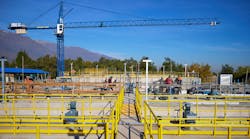Related search terms from www.waterinfolink.com: wastewater treatment, filtration
In order to achieve more stringent effluent limits, the city of Flagstaff, Ariz., worked with Black & Veatch to upgrade the Wildcat Hill Wastewater Treatment Facility (WWTF) in northern Arizona.
The facility produces a high-quality effluent, as well as reclaimed water, which is distributed throughout the region to construction companies and golf courses. The remaining treated water is discharged into the Rio de Flag Creek. The plant has a design influent annual average flow of 6 million gal per day (mgd).
Plant Overview
The Wildcat Hill WWTF consists of primary, secondary and tertiary treatment. The primary treatment includes two bar screens and a grit removal chamber, followed by four clarifiers. Secondary treatment previously consisted of biofilters. These were replaced with a Kruger AnoxKaldnes Hybas system, which consists of media, air grids, screens and screen supports. The effluent leaving this system enters five secondary clarifiers.
Traveling bridge media filters were previously utilized for tertiary treatment, followed by chlorination and dechlorination. Two Kruger Hydrotech Discfilters were installed to provide filtration in the new design. Biosolids are processed through two anaerobic digesters, a centrifuge and two stabilization ponds. This produces Class B sludge used for land application during the summer months.
Process Solution
In order to meet more stringent effluent limits, the Wildcat Hill WWTF incorporated Kruger’s Hybas and Hydrotech Discfilter system to treat a design flow of 6 mgd for biological treatment at a minimum temperature of 14°C. The facility was required to meet effluent limits of soluble BOD <10 mg/L, TSS <10 mg/L, NH3-N <0.5 mg/L and NOx-N <8 mg/L.
The AnoxKaldnes Hybas system consists of two trains. Each train contains an anoxic basin, followed by two oxic Hybas basins. The oxic basins contain a total of 83,720 ft of AnoxKaldnes K3 media, medium bubble air grids and screens to retain the media. The system contains both free-floating biomass (activated sludge) and biomass attached to the AnoxKaldnes media. The free-floating biomass passes through the reactor and is settled out and recycled back to it. The media with the attached biomass are retained in the reactor with cylindrical screens.
Following the secondary clarifiers, the system is required to provide turbidity reduction to a final effluent average of <2 NTU based on Arizona Class A requirements. Two Kruger HSF2220-2F Discfilter units were provided to meet these requirements and provide one filter unit redundancy. The Discfilter has a compact footprint and low operating headloss, allowing the site to utilize one of the four concrete basins housing the traveling bridge media filters for installation. The units were easy to fit into the existing basin dimensions and met the hydraulic profile requirements.
High-Quality Effluent
The effectiveness of the Hybas system, followed by the Discfilter, has allowed the Wildcat Hill WWTF to produce a high-quality effluent for its reclaimed water that is distributed around the area, while also maintaining the existing footprint of the facility.
Download: Here

